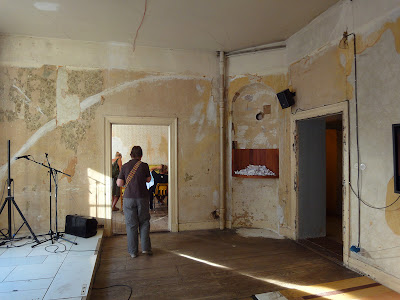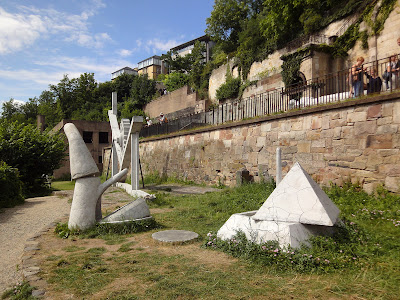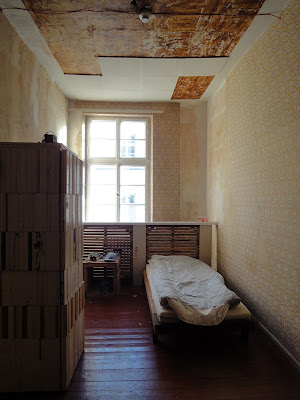The most striking works in dOCUMENTA (13) were outside of the main exhibition venues. They occupied specific locales and brought a new layer of meanings to their already rich histories.
Jennifer Allora and Guillermo Calzadilla took over part of the Weinberg Bunker, a Nazi-era brick bomb shelter built into a hillside, for their new film involving a recently unearthed prehistoric flute and a griffon vulture – one of the oldest species on earth. Argentinian artist Adrián Villar Rojas populated the upper terraces of Weinberg with his plaster and concrete sculptures. These curiously shaped objects revealed a parallel universe or a vanished civilization, creating some foreign yet familiar atmosphere.
 |
| Weinberg Bunker |
 |
| Allora & Calzadilla, Raptor’s Rapture |
 |
| Adrián Villar Rojas, Return the World |
Turkish artist Cevdet Erek had his sound installations at Kunsthalle Basel earlier this year. This time at d(13), he occupied a large vacant space and transformed it into a similar installation. In a minimalistic setting, various types of sound systems amplified what he called “sonic time lines.” In this raw vacant space between Galeria Kaufhof and C&A, the piece looked much more powerful and stunning than in a museum setting in Basel.
 |
| Cevdet Erek, Room of Rhythms |
In the northern depot of the Hauptbahnhof, Haegue Yang put up a series of venetian blinds on the abandoned tracks. These motorized blinds moved up and down with slats rotating, performing a ghostly choreographed dance that evoked the place’s industrial past.
 |
| Haegue Yang, Approaching. Choreography Engineered in Never-Past Tense |
Chicago-based artist Theaster Gates took over Hugenottenhaus – a large old house destroyed in WWII and left empty since the 1970s – and refurbished it with scrap wood he salvaged from abandoned buildings in both Chicago in Kassel, as if to graft his own cultural existence to a German past and to patch up the trauma of war. Aesthetically it reminded me of Gordon Matta-Clark. But it was essentially different because the house was more alive in this case. Gates turned it into an ongoing construction site where furniture was constantly being built, and at the same time a live-in laboratory where talks, music performances, dinner, and Ping-Pong games happened. Gates and his team occupied the house, and the visitors occupied their work. The experience was a rather engaging and voyeuristic act of exploration and discovery.
 |
| Hugenottenhaus |
 |
| Lawrence Weiner’s work on the wall |
 |
| Theaster Gates, 12 Ballads for Huguenot House |
In a very dark room in the backyard of Hugenottenhaus, Tino Sehgal orchestrated another immersive performance piece. About 20 performers sang, danced, clapped, hummed, whispered, and hollered, creating an electrifying experience of free imagination in action. It’s the perfect example of the intangible dimension of art that was celebrated in dOCUMENTA (13). The room was filled with energy just by this series of simple collective activities.
































No comments:
Post a Comment